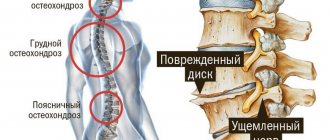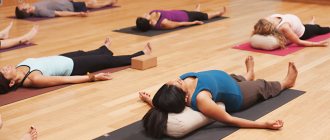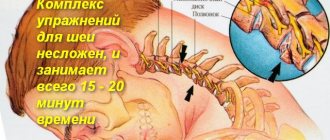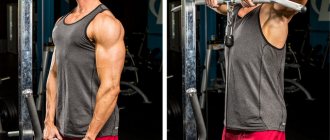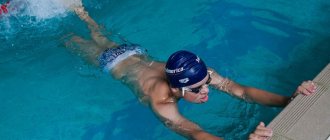The benefits of gymnastics
A herniated cervical spine is a pathological displacement of the intervertebral disc. The main symptoms include acute pain in the spine due to the created pressure on the spinal canal, headaches, and neurological disorders. The fight against the disease includes therapeutic exercises. Exercise therapy for a herniated cervical spine is aimed at achieving the following results:
- Elimination of manifestations of acute pain syndrome.
- Strengthening the muscles in the neck area.
- Relieving spasms, stiffness and tightness.
- Strengthening the flexibility of the spinal column.
- Restoration of metabolic processes and blood circulation in the affected area.
- Eliminating the possibility of relapse of the pathology.
The set of exercises is selected individually, depending on the stage of the pathological process, the presence of concomitant diseases, and contraindications. Its independent correction, changing the intensity of exercise or excluding certain actions is unacceptable, as it leads to an exacerbation of the condition.
Mackenzie Exercises: Pain Relief Activities
The treatment complex developed by McKenzie is intended for patients with osteochondrosis of the cervical spine in an advanced stage. This diagnosis indicates that the cartilage discs are very weakened. Exercises allow you to stretch the muscle frame and restore lost mobility to the intervertebral discs.
- Get on all fours. Arch your back, raising your head. Stay in this position for 5-10 seconds. Then make the opposite movements: stick your back out and lower your head down.
- Stand so that your back is as straight as possible. Slowly, lowering your chin, touch it to your chest.
- Lie on your back. To alleviate the unpleasant manifestations of the disease, place a rolled towel or other cushion under your neck. Slowly raise your arms until they touch the floor.
You can perform this treatment complex 10-15 times a day. The number of repetitions is selected depending on how you feel.
Note!
Pain that appears during training in the back area is not considered a reason to stop training or reduce its intensity. The number of repetitions is reduced if pain appears in the shoulders or neck.
General recommendations for conducting classes
Exercises for a herniated cervical spine are always performed smoothly, without sudden movements. Caution is key, as the entire area of the spine in the shoulder girdle is extremely vulnerable and can be easily damaged by harsh actions. Therefore, it is recommended to follow a number of simple rules during training:
Shishonin’s neck gymnastics + video
- All actions are carried out strictly under the supervision of a specialist, in a specialized office.
- The duration of daily training is 15-30 minutes. You can start with 5 minutes and gradually increase the duration as your muscle corset strengthens.
- It is recommended to perform exercises for cervical hernia in the first half of the day to enhance the effect.
- You should not engage in physical activity before bed or after eating. After breakfast or lunch, at least 1 hour must pass before you can start exercising.
- It is recommended to conduct training in a well-ventilated room, with a temperature no higher than 22 degrees. For classes, you should choose comfortable clothes made from natural fabric that do not restrict movement.
- If acute pain occurs, it is recommended to stop the exercise and consult a doctor.
Exercises can be preventive, aimed at increasing muscle tone, restorative, as part of a course of treatment, and gentle for carrying out during the acute and subacute period of the disease.
A simple and effective exercise for cervical hernia
Prevention
A herniated cervical spine is a very painful disease. In addition to daily discomfort, the disease brings its “owner” severe pain during the period of exacerbation and the inability to lead a full life.
We list the recommendations of experienced doctors with the help of which you will be able to avoid dangerous pathologies of the spine:
- Control your weight. Extra pounds place additional stress on the spine and other joints.
- Exercise regularly using spinal stretching exercises.
- Give up a passive lifestyle by combining training and other active activities: swimming, dancing, walking.
- Get your blood clotting checked regularly.
- If you experience any pain or discomfort in your back, seek medical help immediately. Timely treatment is the guarantee of a quick recovery and relief of symptoms.
- Strictly follow all doctor's instructions: regularly attend exercise therapy and massage, take medications.
Monitoring the condition of the spine and the discs that make it up should be carried out at any age. The hernia is constantly “getting younger”; it is diagnosed in very young people. Therefore, it is very important to ensure that the disease does not appear. And if diagnosed, begin treatment immediately.
Exercise therapy for herniated cervical spine
Therapeutic exercises are only part of therapy and are not used independently. The high effectiveness is due to the use of exercises in combination with medications (anti-inflammatory drugs, muscle relaxants, B vitamins). Each period of the disease has its own methods for improving the condition.
Complex for the acute period
Gymnastics is aimed at strengthening the muscle corset and increasing blood circulation. Therefore, it is prescribed mainly during the patient’s comprehensive recovery. But simple actions during the acute period are useful. The following actions are recommended for a hernia in the neck:
- Lie on the floor or a flat surface, relax your arms and legs, close your eyes. Relax all the muscles of the body as much as possible. You will need to remain in this position for 5 minutes.
- In a lying position, extend your arms along your body and gradually bend and straighten your fingers. Everything is done quickly with little effort when compressing.
- Sit on a chair, place your hands on your hips, palms down. Gradually rotate your shoulders. First one way, then the other.
- Sit comfortably on a stool, lower your arms down and relax them as much as possible. Gradually raise your arms up and spread them to the sides. Return to starting position.
Strength exercises or any attempts to intensively impact the damaged area are prohibited. 5-10 approaches are enough for one workout. In the presence of acute pain, all exercises are carried out only in a lying position.
Complex in the subacute period
Therapeutic exercise in the subacute period allows you to relax the muscles and quickly get rid of unpleasant symptoms. They are performed with caution so as not to provoke a worsening of the condition. Experts recommend the following exercises:
- Lie on your stomach and slightly raise your shoulders above the surface. There should be a slight tension in your back. Hold for a few seconds and then return to the starting position.
- Lie on your stomach on a flat surface, gradually raise your legs. There should be an angle of 10-20 degrees between them and the floor. Hold them in this position for several minutes, then return to the starting position.
- Lie on the floor on your back, gradually alternating between raising your shoulders and legs.
When performing, do not raise your limbs too high. An angle of 10 degrees is recommended. If possible, it is better to involve an assistant who will monitor the correct execution of each approach.
Dikul exercises for hernia
Oddly enough, a very effective method of treating spinal pathologies was developed not by a doctor, but by a circus gymnast.
This is Valentin Ivanovich Dikul . More than 50 years ago, while performing a dangerous stunt, he fell off the trapeze and received many serious injuries, including a broken spine. Doctors predicted he would become disabled. Dikul could not come to terms with this and began a difficult and lengthy struggle for the ability to move and lead a full life.
The result of his perseverance and extraordinary thinking is the unique Dikul system . Thanks to this technique, the author himself was able to get back on his feet .
The most amazing thing is that Valentin Ivanovich not only overcame the pain and accompanying symptoms, but also returned to the circus arena after 8 years. He proved by his example that after severe injuries, you can continue an active life without pain in the spine. Until now, the author is improving his technique, which gives hope to many people with pathology of the spinal column.
The essence of the technique
To properly perform physical exercises with this pathology, you must follow certain rules. you maintain the correct tempo during your workout and use only acceptable loads.
The duration of classes should increase gradually , otherwise long training at the first stage can only aggravate the situation. To restore the functions of the spine, the patient will have to put in a lot of effort, as this is a long and rather painstaking work.
The main thing is to unquestioningly follow all the doctor’s recommendations.:
- Maintain your posture. Corsets and special bandages will prevent sprains and also control movements.
- Gymnastics should be combined with manual therapy, mud therapy, massage and hirudotherapy.
- Physical activity is strictly dosed. Discomfort and the slightest pain mean that you need to reduce the weight of the counterweights on sports equipment.
- Jumping and sudden movements must be avoided.
You need to train regularly, as even a short break will affect your health.
The healer's system works for all pathologies of the spine:
- Serious injuries.
- Osteochondrosis.
- Hernias.
- Acquired scoliosis.
- Cerebral paralysis.
With proper persistence and medical supervision, the pain syndrome will decrease significantly. To avoid complications, it is necessary to strictly follow the instructions of the attending physician.
Video: “Who is Valentin Ivanovich Dikul?”
Charging for the neck
For a herniated disc in the cervicothoracic region, it is recommended to do therapeutic exercises under the supervision of a specialist. The process usually uses special devices, for example, a gymnastic stick. The ideal exercise for fighting a hernia is:
- You should start any workout with a short warm-up. To do this, you need to take a stick in your hands and stretch them in front of you. Then make 12 circular movements in each direction.
- Extend your arms with the stick in front of you so that they are at shoulder level. Gradually tighten your fingers, squeeze them with force. Stay in this position for a few seconds. Lower your arms and repeat the approach several times.
- Take the gymnastic stick almost by the edges, as far as your arms reach. Slowly turn the machine one way, then the other. Perform 12 turns.
- Clasp your hands, place them on the back of your head, spread your arms to the sides. With your head, slowly press on your palms, creating slight resistance, and thereby activating the work of your neck muscles.
- Place your hands behind your head, clasp them, bring your elbows together, keep your back straight. Try to lower your head to your chest with your hands, and at the same time, through the work of your muscles, keep it in one position.
For a herniated spine, regardless of its location, various therapeutic exercise techniques are used. They were developed by doctors with extensive experience and have a minimum number of contraindications. The exercise therapy complexes of Bubnovsky, Shishonin, and Dikul have proven themselves well. They are suitable for patients with various musculoskeletal disorders.
Exercise therapy and gymnastics
A set of exercises for a herniated cervical spine is selected by the attending physician individually for each patient. To achieve a good result, you must follow certain rules:
- The duration of one lesson should average from 20 to 30 minutes.
- Perform exercises regularly, several times every day.
- You can take breaks or not. Some people get tired of working out every day. Therefore, once a week they can take a break. But this can be done by those who are doing this not for the first time. If you are just starting classes, you should try to hold out for at least a month without breaks, practicing every day, because the body needs to adapt to the new load.
- It is correct to alternate strengthening and relaxation exercises. If you do exclusively strengthening, all the muscles are overstrained, but if you do only relaxing, there is no effect. It is important to combine them with each other.
Let's look at several popular neck complexes.
Complex 1
Therapeutic gymnastics for a herniated cervical spine includes the following exercises:
- I.p. – sitting, back straight, shoulders at the same level. Raise your hand up, wrap it around your head and grab your ear on the opposite side. Remain in this position for 15 seconds, do the same for the second hand. Repeat 5-7 times.
- I.p. - Same. Tilt your head to the left to feel strong tension in the neck muscles. Freeze in this position, then straighten up and repeat, tilting your head in the other direction.
- I.p. – sitting or standing, shoulders straightened, shoulder blades at the same level. Without tilting your neck, lower your head down. Hold the position for 10-15 seconds, straighten up, and then raise your head up. Repeat the exercise 7 times.
- I.p. - Same. On the count of one, bend your head to the left, trying to reach your shoulder. Fix the position. On the count of 2 - return to I.p. On the count of 3, do the exercise again, but leaning towards the other shoulder.
These exercises are effective because they use all the muscles of the shoulder girdle. The complex must be performed once a day, preferably at the same time every day.
Complex 2
And this complex helps eliminate the hernia and restores normal posture:
- I.p. – sitting on a chair with a straight back, arms relaxed and lowered down. Turn your head left and right so that the range of movement is maximum. If sharp pain appears during this, you can do the exercise quickly, with short movements.
- I.p. - standing. Lower your head down, as if trying to touch your chin to your chest. Hold this position for 10 minutes. Repeat 5-7 times.
- IP – sitting on a chair, back straight. Retract your chin as much as possible, and then tilt your head back. Repeat 10 times. This exercise stretches the back muscles of the neck well and relieves tension.
The gymnastics described above is effective, but it can only be performed after consulting a doctor.
Contraindications
Therapeutic exercises are prohibited for acute pain syndrome that cannot be relieved by medications. At this time, doctors recommend completely eliminating physical activity and maintaining bed rest. Therapeutic exercises will do more harm than good to people suffering from epilepsy, infectious diseases, heart problems, or cancer. Therefore, before starting training, all patients are recommended to undergo a comprehensive examination.
A hernia in the cervical spine is a serious pathological condition. It develops as a result of a sedentary lifestyle. If detected, the doctor prescribes complex treatment, which includes special gymnastics. A correctly selected complex allows you to recover faster, eliminate compression of nerve endings and compression of the spinal cord, and get rid of discomfort. There are no universal exercises; they are selected based on the individual characteristics of the individual patient’s body.
Charging and warming up
A set of exercises should consist of a warm-up, a main part and a cool-down. It is very important. The main goal of warming up is to warm up the whole body, muscles, ligaments. After this come restorative exercises, specific for each specific department. And at the end there is always a cool down, which is used for the purpose of relaxation and rest.
Exercises for intervertebral hernia of the cervical spine begin with performing rotational movements of the head or tilting it left and right, up and down. You can also try to stretch your neck upward while the rest of your body remains motionless. You need to repeat these simple exercises until burning and tingling appears in the muscles. Only after this can you proceed to the main complex.
Gymnastics according to Dikul
In most cases, this technique can restore flexibility and normal mobility to the affected part of the spine. This is an extensive complex of physiotherapeutic procedures, consisting of two exercise therapy schemes that complement each other. The first involves daily morning exercises for the muscles of the back and lower extremities. The second is evening, aimed at normalizing the work of the muscular tissues of the chest, shoulders and neck. The main task of this systematic complex is the development of a muscular corset to support the spinal column.
The evening group of procedures is prescribed after the completion of the morning cycle. It is aimed at imparting elasticity to ligaments and muscle fibers. Academician Dikul’s methodology also includes special procedures:
- Acupuncture.
- Manual therapy.
- Special drinking regime.
Academician Dikul’s method includes a special drinking regimen.
The Dikul technique (kinesiotherapy) is developed individually for each patient. It requires a preliminary complete diagnosis of the condition of the musculoskeletal structures. Only after this a suitable gymnastic complex is personally developed. Classes and physiotherapeutic procedures must be carried out under the supervision of an instructor.
General recommendations
In order for the classes to be useful, you need to follow certain rules. Otherwise, you should not expect a positive effect from exercise therapy. Tips and tricks:
- It is important to exercise regularly. Moreover, the load should increase gradually - from 10-15 minutes in the first classes to 40 minutes in the future;
- It is better to perform exercises in the morning on an empty stomach. In the evening you need to take time to stretch;
- It is important to monitor your own sensations - if pain occurs, you should immediately stop training. Pain syndrome means that the exercise is performed incorrectly;
- each exercise is usually performed 6-8 times;
- Exercises that involve sudden movements and twisting should not be included in the program. Do not run, jump or do strength exercises;
- a set of exercises can be divided into several parts and performed throughout the day.
If you want to learn in more detail how gymnastics is performed to treat cervical osteochondrosis at home, you can read an article about it on our portal.
It is important to do the exercises correctly
Attention! At a minimum, the first exercise therapy classes should be supervised by an experienced instructor. Then you can perform them at home, having received a preliminary consultation with a neurologist.
Treatment methods
There are several methods for treating cervical hernias. The description is presented in the table below.
Treatment of herniated cervical spine
Table. Methods of treating hernias of the cervical spine.
| Method | Description |
| Conservative | Various medications are used to relieve severe attacks of pain. If they do not help, the doctor prescribes strong hormonal drugs that are injected directly into the affected area. After the pain is relieved, the specialist prescribes drugs that help restore the metabolic processes occurring inside the spinal discs - chondroprotectors. |
| Traction | Traction of the spine allows you to improve the mobility of the spinal column and increase the distance between its individual segments. Helps get rid of pain. Performed only in clinics by specialists. Otherwise, the condition can only worsen. The technique is often used for acute pain. |
| Surgical | If none of the methods helps, then the patient will have to resort to surgical treatment. It is also used for very large hernias. |
Dry spine traction
Massage pillow for neck and shoulders
However, there is another method that, of course, will not get rid of the hernia, but will make it possible to forget about constant pain, worsening of the situation and relapses. Now there are many special types of training and exercises, performing which you can achieve a significant improvement in your condition.
On a note! During the recovery period after treatment, doctors may also recommend physical therapy, acupuncture or hirudotherapy. They will help remove the remnants of the inflammatory process.
Hirudotherapy
Physiotherapy
Dikul exercises for the spine are suitable for everyone - those who have problems with the spine, and those who do not. It is simple and effective.
- get on your knees and elbows, inhale;
- as you exhale, you need to lean forward, arching your back, with your legs on the floor and your arms straight;
- the starting position is the same. Raise your legs one by one, swinging them;
- from the initial knee-elbow position, swing your hips alternately to the right and then to the left;
- exercise – “The cat is angry.” From the starting position, arch and bend your back alternately;
- position - lying on your back - with your knees bent. Tilt them in this position alternately, then to the right, then to the left;
- lying on your back, pull your legs bent at the knees to your stomach, then both at once;
- lying on your stomach, do push-ups on your hands and on your toes.
Read also…. Treatment of arthrosis with Lyapko applicators*
Goals, objectives and features of the method
Exercises using the Dikul method at home can be performed without the use of special devices, but in centers opened under the leadership of the academician, simulators developed personally by Valentin Ivanovich are used to treat patients with intervertebral hernias. Training programs are adapted individually for each patient, so before starting training, you need to discuss the proposed complexes with your doctor and make sure there are no contraindications.
Dikul simulator for therapeutic exercises
The exercises that Dikul proposed help solve several problems at once in the complex treatment of spinal hernias. The therapeutic effect of regular training is manifested by the following changes:
- working out deep-lying paravertebral (paravertebral) muscles and restoring normal muscle tension;
- elimination of muscle spasms and swelling;
- normalization of blood circulation and lymph movement in lymphatic vessels;
- strengthening the muscular corset of the spine;
- elimination of pain associated with hypertonicity of the paravertebral muscles or compression of the spinal nerves.
It is possible to achieve elimination of pain when exercising using the Dikul method in just 4-8 weeks, with a significant improvement in the functional state of the spine and its mobility.
Using the Dikul method you can achieve pain relief in 4-8 weeks
Stages of classes
Classes using the Dikul method are conducted in several stages.
Stages of rehabilitation therapy using the Dikul method
| Stage | Peculiarities |
| First | The main task that classes using the method are aimed at at the initial stage is eliminating pain, relieving muscle tension and increasing the overall tone of the body. Exercises at this stage are performed with minimal amplitude and without the use of additional load. Number of classes – 3 times a week. Duration of the first stage – up to 2-4 months |
| Second | At the second stage of restorative treatment, exercises are used to increase muscle strength and strengthen the muscular corset of the spine. You can add strength training to your classes (using your own weight or weights), and also include asymmetrical movements with maximum amplitude in the training program. The number of trainings increases to 4 times a week, and the duration of this stage can be from six months to 2-3 years (depending on the individual characteristics of the patient) |
| Third | The strengthening stage is based on the creation of a healthy motor stereotype, which involves coordination and strength loads, taking into account the identified pathological focus (the segment in which the hernial protrusion is located). Exercises at this stage help create neurophysiological potential and increase endurance, which will make it easier to cope with household, professional and sports stress without pathological effects on the affected segment of the spine |
Dikul has developed a unique system of exercises that will relieve excess stress from the spine
Important! You can begin the second stage of training only after the pain syndrome has been completely relieved. If a person feels pain while doing exercises, such exercises will do more harm than good, since pain is stress for the body, and the natural reaction to stress is tonic muscle tension (including the muscles of the spine).
Class Rules
Valentin Dikul is confident that all patients can achieve positive results in the complex treatment of intervertebral hernias and other spinal diseases using his system, regardless of the severity of injuries, congenital and acquired pathologies. But in order for the classes to be effective, it is necessary to strictly follow the rules that the author developed for stable development of neurophysiological indicators and better adaptation of the body to new loads.
A positive attitude is very important in treatment
- Rule 1. Classes must be regular, without breaks. If the patient has stopped training, it is necessary to start training from the first stage, since muscle tissue very quickly adapts to the intensity of the current load.
- Rule 2. The recommended duration and frequency of classes is 3-4 times a week for 40-50 minutes. At the final stage, the training duration can be up to 1.5 hours, since one of the objectives of the technique is to increase endurance and adapt the body to long-term stress.
- Rule 3. During training, you must monitor the technique of performing the exercises. You can move on to higher amplitudes only after mastering the previous stage of training.
- Rule 4. Only self-confidence and full awareness of why a person needs these trainings and what results he can achieve with strict discipline will help the patient achieve recovery.
It is very important to monitor the technique of performing exercises
Note! Back diseases are a large group of severe pathologies that can extremely negatively affect the functioning of the entire body and internal organs, therefore, before any impact on this area, it is necessary to consult with specialists. If pain or severe discomfort occurs during exercise, you should stop training and consult your doctor to rule out possible complications and exacerbations of existing pathologies.
